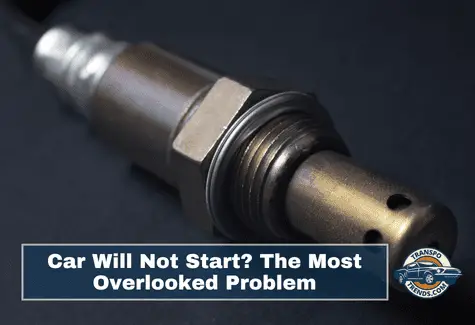You press the start button or turn the key. Nothing happens. Or maybe the engine turns but sputters and dies. You try again—still nothing.
Frustration builds. You open the hood. You are not sure what you are looking for, but you know something is off. Then it clicks. The oxygen sensor!
This small component is often overlooked during diagnostics, yet when it fails—or even just gets dirty—it can disrupt your fuel-to-air ratio, throw off your ignition timing, and yes, stop your engine from starting at all.
In this guide, you will learn how a fouled oxygen sensor can prevent your engine from firing, how to identify the signs, and how to remove, clean, and reinstall it yourself.
What Is the Oxygen Sensor and What Does It Do?
The oxygen sensor—also called the O₂ sensor—monitors the amount of oxygen in your vehicle’s exhaust gases. It is a critical part of your emissions system, and it sends real-time data to your engine control unit (ECU) so it can adjust the fuel-air mixture accordingly.
When it is working properly, it helps:
- Improve fuel economy
- Optimize combustion
- Reduce emissions
- Maintain engine performance
However, if it becomes clogged with carbon deposits, gets soaked in oil, or wears out with age, the sensor can send false readings. Your ECU may respond by injecting too much or too little fuel, which can:
- Trigger engine misfires
- Cause the engine to run rich or lean
- Decrease throttle response
- Prevent the engine from starting altogether in some cases
How to Know Your Oxygen Sensor Is the Problem
Before replacing batteries or tearing apart your ignition system, here are some signs that point to a failing or fouled O₂ sensor:
- Engine turns over but will not start, especially in cold conditions
- Rough idling or sputtering just before stalling
- Check Engine Light with codes like P0130–P0167
- Poor fuel economy
- Strong gasoline smell or visible black smoke from the exhaust
If your engine has been using more fuel than it should there’s a high chance the sensor has built up carbon deposits, which can prevent it from sending accurate signals to the ECU.
Tip: You can scan your car using a basic OBD-II code reader. Codes in the P0130–P0167 range often relate to O₂ sensors.
Step-by-Step: How to Clean and Reinstall an Oxygen Sensor
If your oxygen sensor is heavily fouled but still functioning, cleaning it may restore its performance and get your engine running again.
Tools You Will Need:
- O₂ sensor socket or wrench
- Anti-seize lubricant (optional)
- Wire brush or soft-bristle toothbrush
- Clean rag or towel
- Container with gasoline or carb cleaner
- Safety gloves and eye protection
Step 1: Locate the Sensor
Oxygen sensors are usually located:
- Upstream (before the catalytic converter)
- Downstream (after the catalytic converter)
The upstream sensor has more impact on fuel management. It is usually found screwed into the exhaust manifold or header near the engine.
Look for a plug with a wire leading to a small, cylindrical component screwed into the exhaust pipe.
Step 2: Remove the Sensor
- Disconnect the electrical connector from the sensor.
- Use the special O₂ sensor socket to unscrew the sensor from the exhaust pipe.
- Be careful—do this only when the exhaust system is cool to prevent burns.
Step 3: Inspect for Carbon Buildup
Take a look at the business end of the sensor. If it is:
- Covered in black soot
- Oily or crusted
- Gray and chalky
Then it has been exposed to excess fuel or poor combustion, and it is not performing well.
Step 4: Clean the Sensor
Important: Do not bang or scrape the sensor tip aggressively. It is a delicate piece of electronics.
Method A: Soak and Brush
- Pour carburetor cleaner or gasoline into a glass jar.
- Let the sensor soak for at least 30 minutes.
- Use a soft wire brush or toothbrush to gently scrub off the loosened carbon.
Method B: Brake Cleaner and Air Dry
- Spray the sensor generously with brake cleaner or MAF sensor cleaner.
- Wipe it down with a clean cloth.
- Let it air dry completely before reinstalling.
Step 5: Reinstall the Sensor
- Apply a small amount of anti-seize to the threads (avoid the sensor tip).
- Screw the sensor back into place and tighten securely.
- Reconnect the electrical plug.
Step 6: Start the Engine and Test
Once the sensor is back in place:
- Close the hood.
- Insert your key or press the ignition button.
- If the oxygen sensor was the issue, you should hear a strong, clean ignition and feel the engine settle into a smooth idle.
If it starts immediately and idles normally, you have likely solved the problem without replacing a single part.
When to Replace Instead of Clean
Cleaning is a great short-term fix, but sometimes replacement is necessary. Oxygen sensors should be replaced every 60,000 to 100,000 miles, depending on the vehicle and driving conditions.
Consider replacing your sensor if:
- The cleaning did not resolve the issue
- The sensor tip is damaged or melted
- You have persistent check engine codes after cleaning
- Your vehicle fails emissions testing
A replacement O₂ sensor typically costs $20 to $100, and even premium sensors rarely exceed $150.
What Happens If You Ignore the Oxygen Sensor?
Ignoring a faulty or dirty sensor can have long-term consequences:
- Catalytic converter damage due to unburned fuel
- Significant drop in fuel efficiency (up to 30%)
- Persistent misfiring, which stresses the engine
- Hesitation, rough shifting, or poor acceleration
Summary:
| Step | What to Do | Why It Matters |
|---|---|---|
| Identify Symptoms | Engine will not start, rough idle, poor MPG | Early clues that the sensor is compromised |
| Locate and Remove Sensor | Use socket and unplug wiring | Prepares for inspection and cleaning |
| Clean with Soak and Brush | Remove carbon deposits with care | Restores sensor’s ability to detect oxygen levels |
| Reinstall and Start Engine | Ensure snug fit and reconnect plug | Verifies if cleaning solved the problem |
| Consider Replacement | If cleaning fails or damage is visible | Long-term solution for reliable performance |

